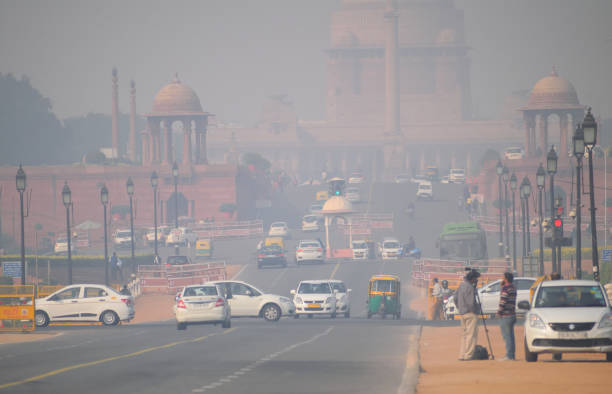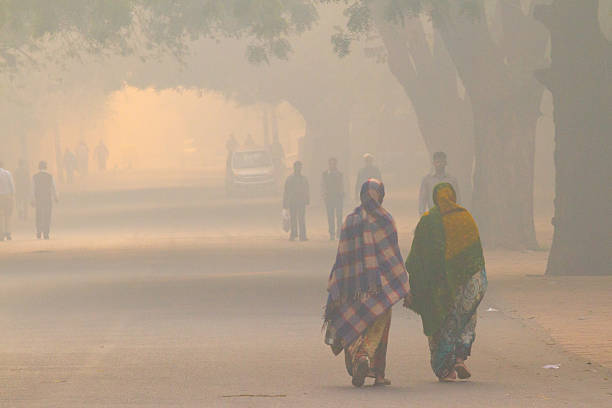Table of content
Air Pollution in Delhi, India: Causes, Effects, and Solutions
Air pollution in Delhi, India, has become a serious problem that affects both people’s health and the environment. The city is often ranked as one of the most polluted in the world. The polluted air, caused by things like factory smoke, vehicle emissions, construction dust, and farming practices, is harmful to the millions of people who live in Delhi. This guide will explain what causes air pollution in Delhi, its effects, and possible solutions to this crisis.
What is Air Pollution in Delhi?

The air in Delhi is very polluted, with tiny harmful particles, especially PM2.5 and PM10, floating around. These particles are dangerous to breathe in. In 2023, Delhi had a PM2.5 level of 92.7 micrograms per cubic meter, much higher than the safe limit of 15 micrograms per cubic meter set by the World Health Organization (WHO). The pollution gets worse during the winter because of weather conditions and human activities.
Causes of Air Pollution in Delhi
Understanding what causes air pollution in Delhi helps us figure out how to fix the problem.
1. Smoke from Vehicles
One of the main causes of air pollution in Delhi is smoke from vehicles like cars, trucks, and buses. The number of vehicles has increased a lot, leading to more harmful gases being released into the air. About 36% of the harmful nitrogen oxides (NOx) and 83% of carbon monoxide (CO) in Delhi come from vehicles. The situation is made worse because many people use private cars instead of public transportation.
2. Factory Smoke
Factories and industries also contribute to air pollution. Many small factories don’t follow pollution control rules, releasing a lot of harmful gases into the air. Factory emissions account for 52% of NOx and 90% of sulfur dioxide (SO2) in Delhi, making them a big part of the pollution problem.
3. Dust from Construction
Delhi is growing rapidly, with a lot of construction happening. This construction creates a lot of dust, which contributes to about 30% of the pollution in the city. Dust from construction sites adds more harmful particles to the air, making it even more polluted.
4. Burning of Crop Residue
Farmers in nearby states often burn leftover crop residue, known as stubble, after harvesting. This practice releases a large amount of smoke and harmful particles into the air, especially during the winter. These pollutants are then trapped in the air due to cold weather, causing a spike in pollution levels in Delhi.
5. Poor Waste Management
Delhi’s garbage disposal practices also add to air pollution. Large landfills, like the Bhalswa Landfill, are often full and sometimes catch fire, releasing toxic smoke. As the waste decomposes, it produces harmful gases like methane, further polluting the air.
6. Weather Conditions
During winter, the weather makes the pollution problem worse. A weather phenomenon called “temperature inversion” traps pollutants close to the ground, and the still air prevents these pollutants from dispersing, leading to thick smog.
How Air Pollution Affects Health
The health effects of air pollution in Delhi are serious. Breathing polluted air can cause many health problems, such as breathing difficulties, heart diseases, and even early death. Children, older people, and those with pre-existing health issues are most at risk. The toxic air has led to a rise in hospital visits and an increase in conditions like asthma and chronic obstructive pulmonary disease (COPD).
How Air Pollution Affects Daily Life
Air pollution in Delhi also has a big impact on daily life. Poor air quality can make people sick, leading to missed days at work or school. The cost of treating pollution-related illnesses is also high, putting more pressure on the healthcare system. When schools close due to dangerous air quality, students miss out on education, which can have long-term effects on their future.
What the Government is Doing to Help
The Delhi government has taken several steps to try to improve the air quality. These efforts are important, but everyone needs to work together to make a real difference.
1. Graded Response Action Plan (GRAP)
The Graded Response Action Plan (GRAP) is a set of rules designed to reduce pollution based on how bad it is. GRAP includes steps like banning diesel generators, introducing an odd-even rule for vehicles (where cars with odd and even number plates can drive on alternate days), and improving public transport to reduce the number of cars on the road during times of high pollution.
2. Promoting Public Transportation
To reduce the number of private vehicles, the government is encouraging people to use public transportation. They have increased the number of buses and expanded the metro rail system to make it easier for people to travel without using their own cars. This helps lower the overall pollution from vehicles.
3. Controlling Factory Emissions
The Delhi Pollution Control Committee (DPCC) is working hard to ensure that factories follow pollution control rules. Regular inspections and fines for those who break the rules are part of the effort to reduce industrial pollution.
4. Raising Public Awareness
Public awareness campaigns are important for educating people about the dangers of air pollution and encouraging them to adopt eco-friendly practices. These campaigns promote the use of cleaner fuels, carpooling, and avoiding firecrackers during festivals. By working together, the community can play a big part in reducing pollution.
5. Using Technology
Technology is also being used to fight air pollution. The government is investing in air quality monitoring systems and pollution control technologies. They are also promoting the use of air purifiers in homes and offices to reduce indoor air pollution.
Conclusion
Air pollution in Delhi is a serious problem that needs to be addressed from all sides. While the government has made progress, there is still a lot of work to be done. Everyone needs to work together—governments, industries, and citizens—to create a cleaner, healthier environment. By following stricter rules, raising awareness, and using technology, we can make a big difference in reducing air pollution in Delhi.
FAQs
1. What is being done to reduce air pollution in Delhi?
The government has introduced several measures, like the Graded Response Action Plan (GRAP), promoting public transport, regulating factory emissions, and raising public awareness about the issue. They are also using technology to monitor and control pollution.
2. Why is the air quality worse in winter?
In winter, a weather condition called “temperature inversion” traps pollutants close to the ground, and the still air prevents them from dispersing, creating thick smog.
3. How Does Climate Change Affect Air Pollution in Delhi?
Climate change can worsen air pollution in Delhi by increasing temperatures and altering weather patterns. Warmer temperatures can lead to higher levels of harmful pollutants, like ground-level ozone. To address this issue, we need to focus on what we can do to tackle climate change, such as reducing emissions and adopting sustainable practices to help improve air quality

Leave a Reply